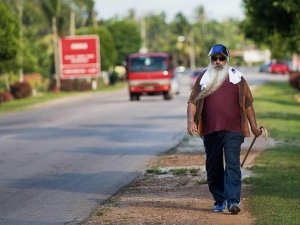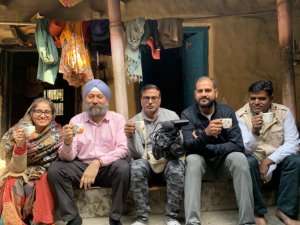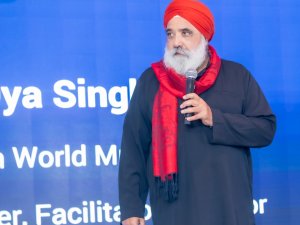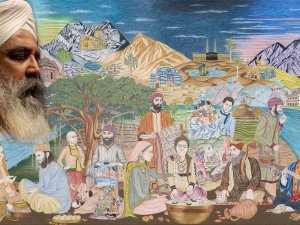[Above image: Gurdwara Baba Gurditta, Nawanshahr]
Over the last decade or so, I have talked, and numerous friends have asked me, about my ‘dream gurdwara’. As I get older and more home-based, I have yearned for a ‘retreat-like’ gurdwara which is in a rural setting for a start, and on acreage. An environment-friendly, ‘green’ sanctuary where one can slow down, feel love, friendliness, and acceptance, and perhaps stay for a few days in tranquil surrounds.
We have, globally, the present-day regular urban and suburban gurdwaras, and more will materialize with Guru Ji’s Grace. They carry out an important service for the community. What we also need are ‘gurdwara retreats’ where now fast-paced city and suburban dwellers can drive out to, and spend some time (maybe a few days) in relaxed surroundings, yet explore the ‘inner self’ or just slow down – a temporary respite for the body and soul from the frantic life that most people lead.
Acreage is important so that there is plenty of space, not only for car parking (a necessary evil these days), but space to build adequate, modest, aesthetic, environment-friendly buildings and other structures which blend into the rural landscape; recreational areas for children and adults, space and structures for walks and exercise; and greenery – trees, bushes and gardens for fruits, herbs, vegetables and flowers. They in turn will encourage birds, butterflies and other fauna.
‘Eco-consciousness’ ‘environment-friendly’ ‘sustainability’ are important catch-phrases of the day and into the future which means use of water, waste and energy minimization devices (mulching, composting, rain water tanks, solar/wind, fossil-fuel-free energy), only using plastics which are reusable, organic farming perhaps; further greening where possible; and general sustainability. General sustainability to me means adding more ‘goodness’ as time goes on, not exploitation – of energy, other resources, cleaner environment (richer soil) and even financial-management.
I know of two such initiatives in Malaysia within one hundred kilometres of capital Kuala Lumpur worth mentioning, and which I hope and pray all Malaysian Sikhs will frequent and support.
One is Khalsa-Land, the inspiration of the Sikh Naujawan Sabha Malaysia in the region of Kuala Kubu Bharu, less than 100km. north of capital Kuala Lumpur. The other is Gurpuri which began as a humble orphanage for Sikh children, extended to assist single mothers from broken homes. It has its base in Kuala Lumpur and now acreage, east of Kuala Lumpur near the township of Bentong. I also know of a ‘sant-dera’ type gurdwara on acreage near the small town of Machap in Johore state. (I do not know for what purposes that acreage is being used for!)
Australia has one such ‘potential’ gurdwara site at Officer, about 50km. south-east of Melbourne in state Victoria.
I was prompted to write about this when a close friend from Brisbane, S. Diljit Singh rang and asked, “so what has happened to your dream of setting up a ‘Sikh Retreat’?”
This ‘dream’ of mine did eventuate temporarily as I had the opportunity of acquiring a beautiful property with a running creek on its boundary, but of only two acres. It turned out to be a ‘practice run’. After five years of its existence, I realized that I could not do this alone or even with family. It had to be a ‘sangat’ project – sangat vich barkat (within holy congregation there is abundance). We carried out occasional Sikh services, inter-faith gatherings, Anand Karaj (weddings), Akhand Path (continuous reading of the Guru Granth Sahib over 3 days), birth initiations, child naming ceremonies and so on. I realized that such a project would lack continuity after I was gone or just not able to continue.
Guru Ji provided the answer. A philanthrophic Melbourne-based Gur-Sikh purchased this acreage (20 acres), a farmlet in the district of Officer, and passed it onto the sangat – a group of dedicated volunteers (sewadhar) who needed a ‘gurdwara’. A most dedicated Bhai Sahib (Giani Upkar Singh Ji) was assigned to this new gurdwara. He has run the services and done sincere sewa for 3 years now. The dedicated group of volunteers are ‘mainstream’ Sikhs, not involved with any ‘jatha’ or a ‘Sant dera’ (Sikh cult groups). Mainstream smagam (services) are carried out besides classes for kirtan and Punjabi mainly for children at this stage.
At present, the resident farmhouse has been refurbished and serves as the gurdwara with modest accommodation for Bhai Sahib. He resided alone for two years. Now a young tabla exponent (Ustad Harjit Singh) has joined him.
A more spacious low building has now been built serving as kitchen and langar hall. It also doubles as dialogue, screen presentation and lecture space. There are no qualms for chairs at the back of the gurdwara or the Langar Hall for those who need them.
Two containers converted to rooms are used for Punjabi and kirtan classes, and a library is growing.
An aesthetically planned car-park has just been constructed for about 60 cars at present. There is an overflow facility for a further 50-60 cars if needed for larger programmes. Each step of the progress is being well planned out. There is always the fear of a multi-story gurdwara which is the way most gurdwaras seem to go! In that case the ‘retreat-like’ atmosphere and environment will disappear.
Of great interest to me are a large organic vegetable plot which is already yielding produce for langar and excess for sangat to take home. A tractor has been purchased and it is heart-warming to see Sikh youth and young adults, and even volunteer students from the local college helping in the garden and the surrounds. Local businesses have been generous in providing vegetable seeds and tree seedlings for planting.
A new septic tank is being installed to collect all waste-water to be treated so that it can be recycled for watering plants and trees.
Health consciousness is slowly growing as far as the food and drink (langar) in the premises are concerned. The organisers have even produced a vegetarian recipe book for health-conscious cooking.
This ‘gurdwara’ has already made into the local news for the ‘greening’ aspect and sewa especially during the pandemic for distributing food for those in need or in lock down due to the pandemic.
There are plans to create a parkarma (walking path) skirting the edge of the property with ‘worms’ running in to create shorter ‘walks’. Benches and other seating logs and stumps will be dotted throughout the ‘walk’. A children’s playground is in the pipeline. Two thousand trees have been planted in the acreage for further greenery.
Kangaroos already frequent the property though they can become a nuisance with the growing abundance of greenery. Bird boxes are being located at prominent sites to encourage more bird-life and with further greening there will be butterflies and other fauna.
A number of other ‘like-minded’ yoga and meditation groups too have started using the facilities for their activities. So long as full respect is accorded to Guru Ji and Guru-Qar, and especially as long as there is no abuse of substances and drugs, and attendees are free of alcohol and meat in the entire area, all are welcome to participate in Sikhi activities or activities approved by the administrators.
A yoga group already has plans to carry out an annual week-long ‘tent and camping retreat’, in the near future.
The potential for such initiatives is immense, but so are the pitfalls. I have seen many good ‘gurdwara’ visions starting along similar lines, sabotaged by cultish groups who like to push their own agenda of Sikh ‘religion’ instead of considering the stress-freeing and developmental needs especially of our younger generations - especially those born in the diaspora. Here, I believe the acreage and rurality, besides dedicated humble, far-sighted front-line sewadhar (service-orientated administrators) are the key.
Much depends on further development from this point on. Next will be what shape and size the inevitable main ‘functions/smagam’ building will take. If that goes the ‘concrete, multi-storeyed-gurdwara’ way then I feel we have lost the plot. If the administrators decide on buildings which enhance the rural, tranquil, and relaxed ambience, then I will suggest we are moving forward.
Australia has a developing consciousness of the acknowledgement of its original inhabitants who, normally, like in most developing countries on the globe, are pushed aside and acquire fringe dwellers status. The gurdwara boasts, firstly, as is right, a solitary Nishaan Sahib in a prominent spot, but on one side are three flags which stand side by side – The Australian and Australian Aboriginal flags flank the Nishaan Sahib to acknowledge firstly, the Sikh life philosophy, our allegiance to Australia and the custodianship of the original inhabitants of this land. There are considerations of raising a plaque to acknowledge the original inhabitants of this land, in the future.
Guru Ji has given me the blessing to see my own dream materializing. It is a 20-minute drive from my current humble abode. I enjoy coming to this ‘gurdwara’ and also for kirtan ‘hajri’ which Giani Ji and the administrators lovingly allow me to, and I enjoy the love and affection of Guru Ji radiated through the sangat that attends. This ‘gurdwara’ reminds me of the gurdwaras of old in my native Malaysia which were small, made of timber, modest in looks but which were welcoming, exuded warmth and love, and relaxed. One felt as if one had come home. As in my formative years, the sangat too is like a big family where everyone is a sewadhar, and acknowledge and love each other.
I see a future where there will be more container-type accommodation scattered throughout the property for those who come for weekend-long activities or just to stay for short periods for reflection, retrospection, simran, meditation, sadhana, dialogues with and counselling sessions with Giani Ji; medical/health information especially for women; youth sessions; Gurbani, gurmatt and kirtan classes, and participating in some form of sewa…or just a cup of cha and read a book in the library!
I can see a multi-purpose, ground floor only, hall aesthetically blended into the ‘green’ environment which can cater for the occasional large Guruqar divans of about three to four hundred strong sangat; for other spiritual activities like yoga and Simran, and even seminars and inter-faith gatherings. The regular daily Guruqar for daily ‘parkash’ should remain small and cozy to cater for sangat which turns up daily or regular services.
There are enough ‘large’ gurdwaras catering for crowds for the major programmes like Vesakhi, Diwali and Guru Nanak’s Gurpurab. This ‘retreat’ is not for large crowds but small devoted sadh-sangat and individual or family spiritual nourishment and progress. (This Vesakhi, for example, we had a 100 strong contingent to participate in the Akhand Path and langgar sewa from the opposite side of Melbourne City!)
I can envision a stadium-like area (akhada) for games like football, hockey, gatka demonstrations, annual Hola Mahala Games and other activities of a physical nature.
Currently there is a disused dam with a creek outlet which can be enhanced and greened adding to the beauty of the property and be an added water source. By the way there already are a few large rain-water tanks for water.
Mulching and composting are already taking place. Rubbish is minimized; langar remains are composted; use of plastic is minimized with a view to complete elimination of its use. Containers for taking away excess langar will be re-usable type. Solar panels for energy are envisaged in the long run. Sangat is encouraged to be more conscious about sustainability and eco-friendly methods and to give suggestions on how improvements can be made.
Unfortunately, for such a vision to succeed, besides continuity of the right management, income generation is important. Perhaps larger-scale organic farming and even bees for honey, on a commercially viable basis could be considered for additional income for the property. Mainly it will depend on the support and enthusiasm of the sangat and most importantly Guru Ji’s grace.
My last point, one of great satisfaction to me, is that no elected committee is envisioned to run this ‘green’ gurdwara. Sincere level-minded humble Sewadhar and natural selection on merit by the ‘elders’ for administrators is a system being considered for the future.
So far so good. May Guru Ji save us from the cultists who might have different ideas of what progress is. At present Guru Ji is kind. Progress is slow and steady and well thought out. The present volunteer administrators and sewadhar, do have a view towards a sustainable future for the property and a sangat which is progressive and who wish to build a centre for the needs of future generations and especially a place which the younger generations are attracted to.
The ‘sangat’ we have at present has to travel a fair distance to get here. So only the dedicated and those who wish to do sewa attend. Their offsprings can not only have an outing and a good time but also learn ‘something’ about Sikhi, Gurmukhi or even learn kirtan and basic Punjabi and basic Sikhi and Sikh history.
Ever jon teri panehari. Is dharti me teri sikdhari. (SGGSp374). Sikh spirit hints that the human is top of the food chain. But with that comes great responsibility as masters of this planet. The resources within, on and around this planet have been gifted only once. If human beings manage them well, they are inexhaustible, but if mismanaged then it could lead to the destruction of humankind.
As Sikhs we need to become part of the solution, not part of the problem.
Footnote: Green Sikh ‘retirement villages’ along similar lines are still a dream, but one which will eventuate as the population in most countries grows older, economic constraints on family units grow more difficult, as family units become smaller and most importantly as eco-consciousness grows. But that is another topic.


















